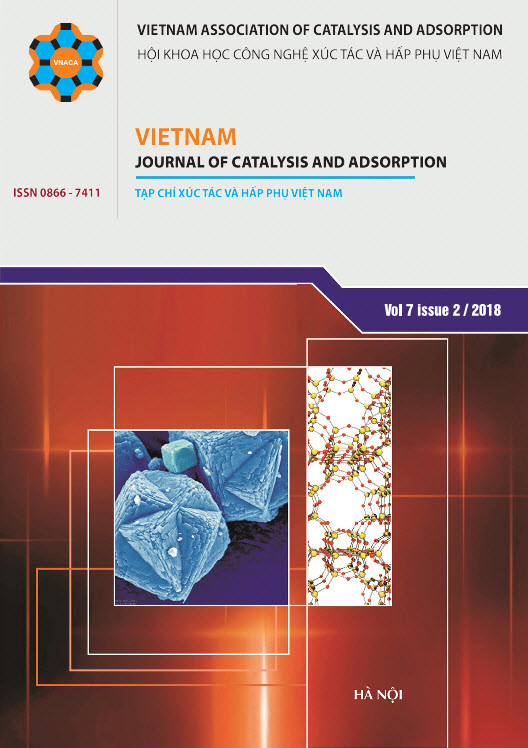Synthesis, structural characterization and adsorption capacity of H-δ-MnO2
Abstract
The H-δ-MnO2 material was synthesized through proton exchange for K-containing δ-MnO2 (K-δ-MnO2) nanoparticles prepared by solid-state reaction. The obtained materials were characterized by X-ray diffraction (XRD), scanning electron microscopy (SEM), energy dispersive spectroscopy (EDS),transmission electron microscopy (TEM), and nitrogen adsorption−desorption measurements (BET). The effects of contact time, initial pH, adsorbent dosage and initial concentration of dye were investigated. The adsorption of methylene blue (MB) as a model organic pollutant on the obtained material, is also followed by Langmuir and Freundlich adsorption isotherm. The high adsorption capacity of H-δ-MnO2 for MB (qmax = 185.5 mg/g) shows this material can be used as an effective adsorbent for dye wastewater treatment.
Downloads
References
S. Shakoor and A. Nasar, “Removal of methylene blue dye from artificially contaminated water using citrus limetta peel waste as a very low cost adsorbent,” J. Taiwan Inst. Chem. Eng., vol. 66 (2016), 154–163.
S. Devaraj and N. Munichandraiah, “Effect of crystallographic structure of MnO2 on its electrochemical capacitance properties,” J. Phys. Chem. C, vol. 112, no. 11 (2008) , 4406–4417.
T. Gopi et al., “Catalytic decomposition of ozone on nanostructured potassium and proton containing δ-MnO2 catalysts,” Catalysis Communications, vol. 92 (2017), 51–55.
E. Using, M. O. Diatomite, S. J. Allen, and M. N. M. Ahmad, “Molecular Size on the Removal of Dyes from Textile Effluent Using Manganese The Effect of pH , Temperature , and Oxides-Modified Diatomite,” vol. 76, no. 7 (2016), 2655–2663.
Y. Liu, C. Luo, J. Sun, H. Li, Z. Sun, and S. Yan, “Enhanced adsorption removal of methyl orange from aqueous solution by nanostructured proton-containing δ-MnO2,” J. Mater. Chem. A, vol. 3, no. 10 (2015), 5674–5682.
A. Zahoor, H. S. Jang, J. S. Jeong, M. Christy, Y. J. Hwang, and K. S. Nahm, “A comparative study of nanostructured α and δ-MnO2 for lithium oxygen battery application,” RSC Adv., vol. 4, no. 18 (2014) , 8973.
W. Xiao, W. Zhou, H. Yu, Y. Pu, Y. Zhang, and C. Hu, “Template synthesis of hierarchical mesoporous δ-MnO2 hollow microspheres as electrode material for high-performance symmetric supercapacitor,” Electrochim. Acta, vol. 264 (2018), 1-11.
B. Zhao, R. Ran, X. Wu, and D. Weng, “Phase structures, morphologies, and NO catalytic oxidation activities of single-phase MnO2catalysts,” Appl. Catal. A Gen., vol. 514 (2016), 24–34.
M. A. Al-Ghouti, Y. S. Al-Degs, M. A. M. Khraisheh, M. N. Ahmad, and S. J. Allen, “Mechanisms and chemistry of dye adsorption on manganese oxides-modified diatomite,” J. Environ. Manage., vol. 90, no. 11 (2009), 3520–3527.
W. F. Tan, S. J. Lu, F. Liu, X. H. Feng, J. Z. He, and L. K. Koopal, “Determination of the point-of-zero charge of manganese oxides with different methods including an improved salt titration method,” Soil Sci., vol. 173, no. 4 (2008), 277–286.
D. Jirekar, A. Pathan, and M. Farooqui, “Adsorption studies of Methylene blue dye from aqueous solution onto phaseolus aureus biomaterials.,” Orient. J. Chem., vol. 30, no. 3 (2014), 1263–1269.
Downloads
Published
Issue
Section
License
Copyright (c) 2018 Vietnam Journal of Catalysis and Adsorption

This work is licensed under a Creative Commons Attribution-NonCommercial 4.0 International License.











